Algae and Lichens and Fungi….Oh My!
Am I on a Yellow Brick Road somewhere?
No, it is just that I am a fan of these types of plants or organisms. I have written previously about mosses, but I also like the small lichens that grow on some of my older hypertufa planters.
You may have seen them growing on your hypertufa. Lichens also grow on stone and tree bark and are fascinating to look at up close. It is said that lichens are sensitive to air pollution, so I can only assume that the air here in this part of Ohio is in pretty good condition.
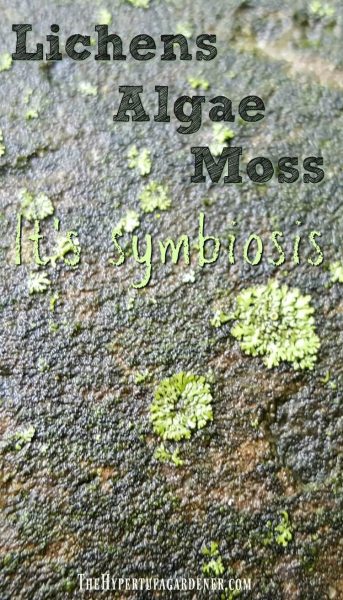
I had classes when I studied to become a Master Gardener and I thought the slides and close-up photographs that were displayed were so awe-inspiring. These tiny organisms grow slowly over long periods of time .
” It is quite common for a lichen to have a lifespan of several centuries if left undisturbed and with a suitably long-lived substrate.” Quoted from Air Pollution Information System ” Impacts of air pollution on Lichens and Bryophytes ( mosses and liverworts)
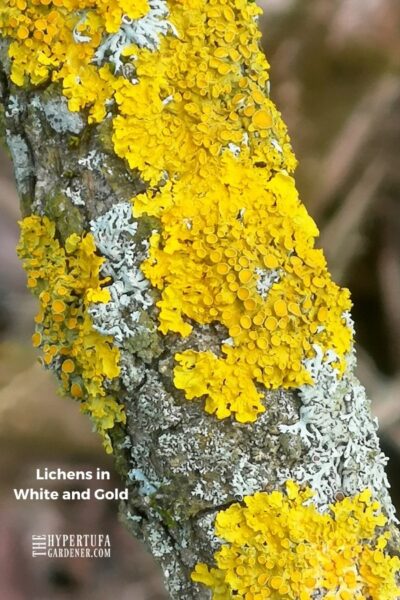
I think I might try and grow some in a terrarium. Either it will or it won’t grow. I can call it an experiment. I will update you when I get that going. It should be interesting. Click through to my index for more posts on my Backyard Flower Garden.
Lichens – are they parasites?
Lichens don’t have roots or stems, not even leaves. They live in a symbiotic relationship with mosses and algae. Mosses and lichens are usually together because they live in a “partnership” with each other.
Normally algae could not survive in harsh environments, but lichens give them a means to survive. Lichens absorb everything including pollutants which contain heavy metals or carbon and sulphur.
It is absorbed through the thallus which is that most visible part of the organism such as the “leafy” form this one is displaying on the tree. (photo below)
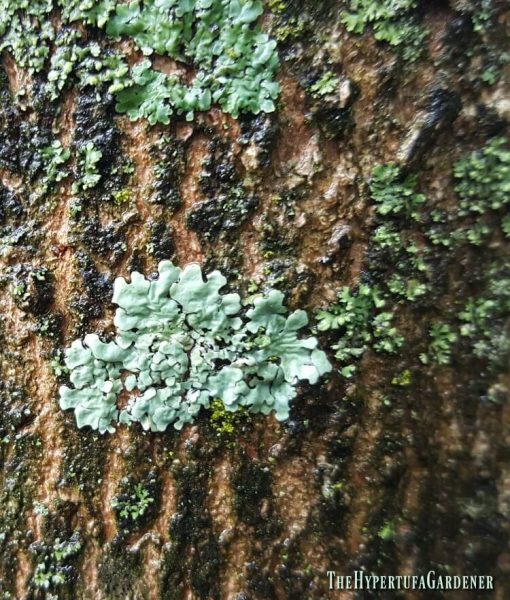
Types of Lichens
Foliose lichens usually have a top and bottom side. You may see some that look like leafy lettuce. This is the type I see on my trees.
Leprose lichens are usually like a fine dust on a substrate.
Fruticose lichens are branched or hairlike and some even have “cup” structures.
Crustose lichens are just….crusts. They form over a surface like a stone or even roof shingles. These lichens can be many colors and mostly are flat against their substrate.
This crustose type is found on great stone formations and gives them color. A gravestone gradually develops them over time when it is left undisturbed.
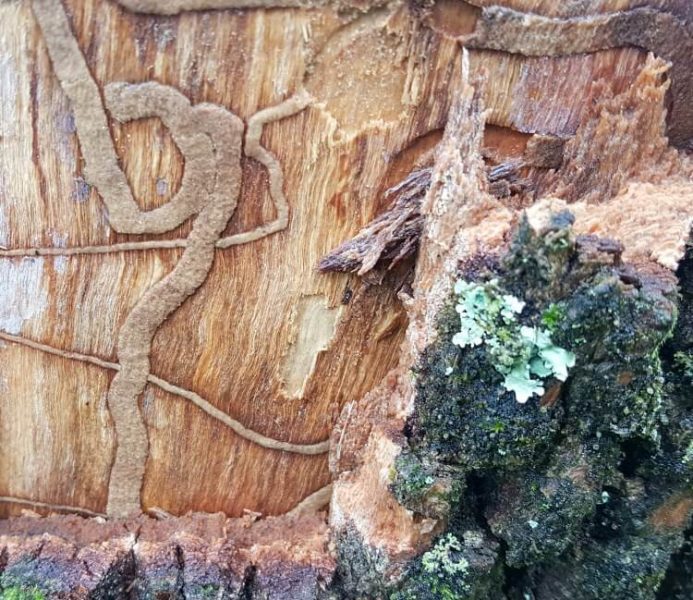
This old ash tree stump is from an ash tree that we had to take down due to the Emerald Ash Borer. You can see the trails of the borer as it worked its way up and down and across under the bark of the tree.
Eventually the EAB destroys the tree’s ability to bring water and nutrients through that layer of the tree and up to the top. When the tops of the trees are dead and dying, you can expect that it is well into a deadly infestation.
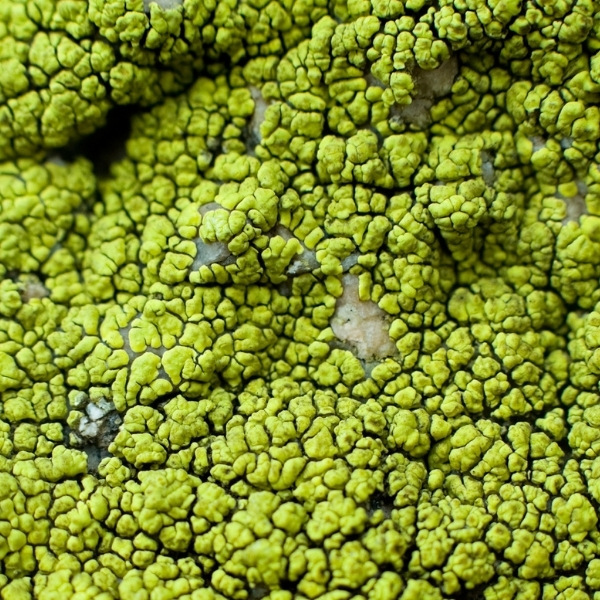
I wrote about our trees here in this post. We lost large and old trees and it was a terrible thing. But the lichens lived on.
Next time you are out walking, see how many times you come upon a lichen of some kind. Look closely and you can see a whole tiny little world.
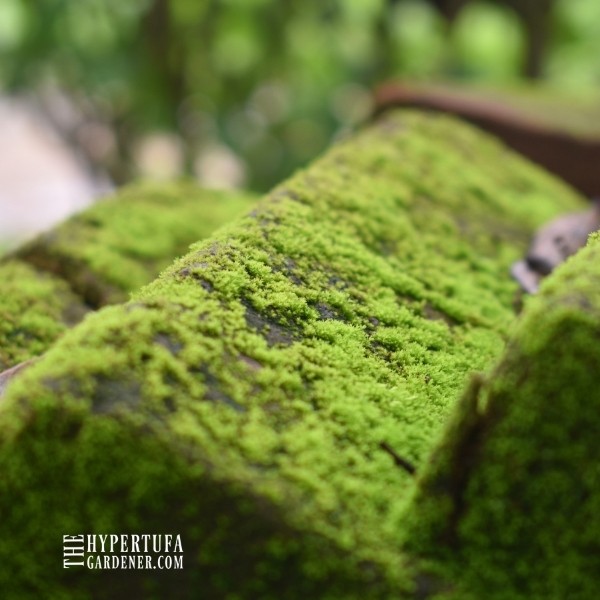
All of the mosses and lichen and fungi are fascinating to look at and to photograph up close. The mosses and algae growing on the structures all around us will be here when we are all gone. On that you can depend!


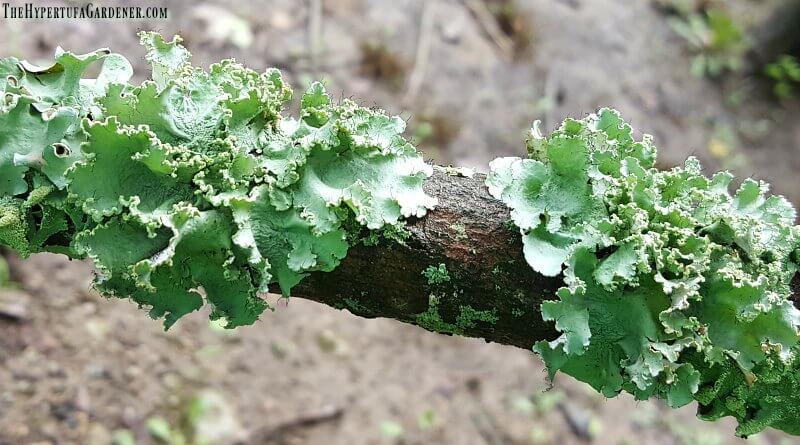
Thanks Kim for this info. I often wondered what that moss was called. I have it almost everywhere on items in my yard.
You’re so welcome and thank you for visiting and taking the time to make a comment. I appreciate that so much.
Good article. My husband told me that lichens are a good indicator of good air quality.
They do seem to have that reputation! Thanks.
Kim: Good article. I noticed lichens growing on rocks and trees here in southeastern PA a few years and asked my husband about them. He agrees that they are a sign of very good quality air!
Thanks for dropping by. Glad you found it interesting.
I’ve developed more of an appreciation for moss and lichens in recent years but didn’t know much about them, so this was very interesting. Sounds like they do some things that are helpful to our health. I’ll appreciate them even more now!
I’ll admit I learned a lot researching this. And I find them so interesting. I love looking for them now all over the place.
Great post! Living in Costa Rica I am fascinated by algae and lichens. By the way have you ever read The Signature of All Things by Elizabeth Gilbert? I think you would absolutely love it, the main character is fascinated by lichen and studies it intensely, one of my favorite novels!
Welcome Kari, and I have not read that book. I will need to get it since it sounds right up my alley.